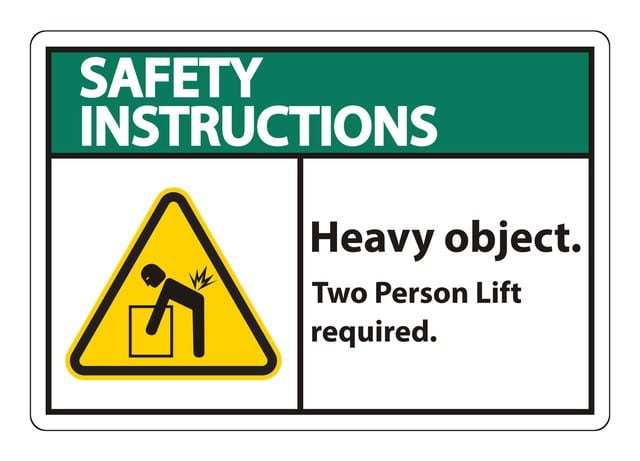Lifting Like a Pro: Best Practices in Workplace Safety
Workplace safety is crucial for any organization, regardless of industry or size. Among the various safety concerns, proper lifting techniques are often overlooked, leading to many workplace injuries. Whether you work in a warehouse, a construction site, a healthcare facility, or an office, understanding and implementing safe lifting practices is crucial.
The Importance of Proper Lifting
Improper lifting techniques can result in various musculoskeletal disorders (MSDs) and injuries, from minor strains to severe back injuries. These injuries pose a significant risk to workplace safety, affecting the muscles, joints, nerves, tendons, ligaments, and other supporting body structures. These injuries and disorders can result from repetitive motions, awkward postures, or heavy lifting. Workplace safety measures are imperative for preventing MSDs, including proper lifting techniques, regular breaks to alleviate strain, and employee education on posture and body mechanics. Workplace injuries not only cause physical suffering but also have economic consequences for both employees and employers. Lost productivity, medical bills, and worker’s compensation claims can all affect a company’s bottom line. Therefore, investing in proper lifting training and promoting a safety culture is a wise business decision.
Best Practices in Workplace Safety: Lifting Objects Safely
Material handling and safe lifting in the workplace are critical components of occupational health and safety. Effective material handling involves using proper techniques and equipment to move, store, control, and protect materials throughout the manufacturing, warehousing, and distribution processes. Safe lifting practices prevent injuries like strains, sprains, and more severe musculoskeletal disorders. Workers should be trained to assess the weight and stability of loads, use mechanical aids like forklifts or hoists when necessary, and employ proper body mechanics—bending at the knees, keeping the back straight, and holding the load close to the body. Implementing these strategies helps maintain a safer work environment, enhances productivity, and reduces the risk of workplace injuries. By adhering to best practices for safe lifting, organizations demonstrate a commitment to the well-being of their workforce, fostering a culture of safety and empowerment. Here are some of those best practices:
- Implement Controls: Consider whether there is an alternative to lifting a heavy load. Could a cart, hand truck, or forklift be used? Would a lift, hoist, crane, or pallet truck be appropriate to move the heavy load? Is it possible to reduce the weight of the load by disassembling larger objects into smaller, more manageable parts? By meticulously considering these engineering solutions, lifting tasks can be executed safely and effectively across various industries, from construction sites to manufacturing facilities.
- Plan the Lift: Before lifting an object, assess the situation. Determine the weight and size of the object, the distance it needs to be moved, and the path you’ll take. Plan all parts of the lift, including lifting, carrying, and setting down. If the object is too heavy or awkward to lift safely, seek assistance or use a mechanical aid. Lastly, environmental factors like weather conditions and terrain must be carefully evaluated to adapt lifting strategies accordingly.
- Clear Pathways: Before moving an object, ensure your path is clear of obstacles and hazards, and the floor is dry. Remove any potential tripping hazards and ensure adequate lighting if you’re working in dimly lit areas.
- Use PPE (Personal Protective Equipment): Wear gloves that fit properly with good grip, steel-toed boots, or appropriate footwear for the task.
- Warm Up: Just like athletes warm up before physical activity, workers should warm up their muscles before lifting heavy objects. Simple stretching exercises can help prepare the body for the task ahead and reduce the risk of muscle strains.
- Maintain Good Posture: Proper posture is essential for safe lifting. Stand with your feet shoulder-width apart, bend at the knees (not the waist), and keep your back straight. Tuck in your chin to align your head with your spine. Avoid twisting your body while lifting.
- Use the Power Zone: The power zone for lifting is close to the body, between mid-thigh and mid-chest height. Push through your heels to stand up while keeping the object close to your body. Keep your abdominal muscles engaged to support your spine.
- Avoid Overreaching: Do not reach out to pick up an object that is too far away. Instead, move closer to the object and lift it from a comfortable position.
- Grip and Hold Securely: Ensure you grip the object securely before lifting it. Use both hands and, if possible, wear gloves for better grip. If the object has handles, use them.
- Move Smoothly and Slowly: Avoid sudden, jerky movements when lifting or lowering an object. Move slowly and maintain control. Rushing increases the risk of accidents.
- Team Lifting: Never hesitate to ask for help with heavier or bulkier items. Team lifting reduces the risk of injury and makes the job more efficient.
- Know Your Limits: Be bold and admit when an object is too heavy to lift safely. Pride should never outweigh safety. Seek assistance or use mechanical aids when needed.
- Take Microbreaks: A study (www.mdpi.com) found that muscle fatigue was a factor in workers’ developing work-related MSDs (musculoskeletal disorders). The study found a substantial difference between workers who took small breaks and those who took no breaks. A small, short break can be a preventative measure to reduce the risk of MSDs.
- Regular Training and Education: Employers should provide regular training sessions on proper lifting techniques and safety protocols. Employees should be aware of the latest best practices and guidelines.
Incorporating safe lifting practices into your workplace culture is a win-win situation. Employees benefit from reduced injuries and improved well-being, while employers enjoy increased productivity and lower healthcare costs. By following these best practices and promoting a safety culture, organizations can ensure that their workforce lifts safely, minimizing the risks associated with improper lifting techniques. Remember, safety should always be a top priority in the workplace.
Prioritizing safe lifting practices in the workplace is paramount to ensuring employees’ well-being and the organization’s success. If you seek comprehensive safety training to implement these practices effectively, look no further. Contact us today at 919-417-2139 for tailored safety training programs to meet your organization’s needs. With our expertise in safety consulting and training, we’re committed to equipping your team with the knowledge and skills necessary to create a safer work environment. Don’t wait until it’s too late—invest in safety training today to safeguard your workforce and enhance organizational performance.


